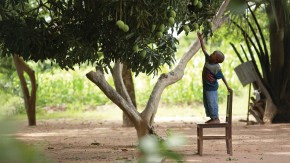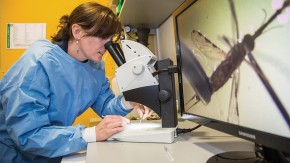James Dale works together with a colleague in one of the labs used to genetically engineer bananas with increased pro-vitamin A and iron levels.
DEVELOPMENT OF BANANAS WITH OPTIMIZED BIOAVAILABLE MICRONUTRIENTS
- Jan 1, 2016
- Download Retrospective
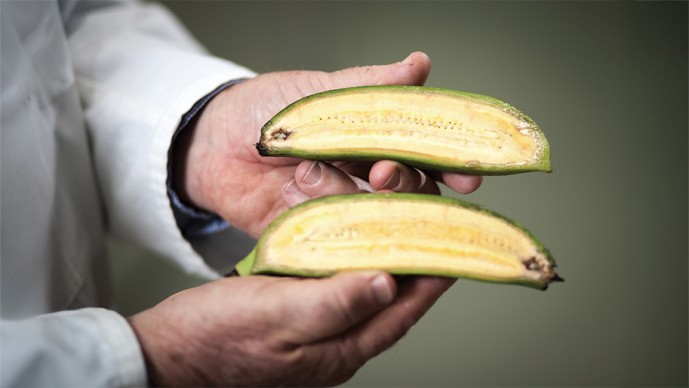
The golden banana, fortified with pro-vitamin A.
James L. Dale, Queensland University of Technology, Australia
Wilberforce Tushemereirwe, National Agricultural Research Organization, Uganda
In a field in Uganda guarded by a chain link fence topped with barbed wire, scientists are conducting an experiment that may have the single greatest impact in improving the health of millions of African children.
After more than 10 years of research, a small team of Ugandan plant biologists supported by scientists in Australia have genetically modified two banana plant cultivars to contain up to four times more pro-vitamin A than bananas that are a major part of the country's diet. The scientists are based at a government-funded agricultural research facility in Kawanda, a small town about an hour's drive northwest of Kampala, the country's capital. The Kawanda researchers are also growing the first indigenous bananas genetically engineered to produce a three-fold increase in dietary iron. If all goes as planned, in about six years banana plants fortified with enough pro-vitamin A and iron to meet half the daily requirement of the nutrients will be distributed to a small number of Ugandan farmers with the hope that others with small-holding farms will also start growing the hyper-nutritious bananas in the following years. A deficiency of vitamin A and iron in the Ugandan diet is a major cause of impaired eyesight, anemia, and a weakened ability to fight off viruses and bacterial infections. In Uganda, more than 40 percent of young children have stunted growth and 73 percent are anemic due to the shortage of iron in their diet.
"We were looking for the single best way to address the deficiency of micronutrients - iron, zinc and vitamin A - that causes so many health problems," says Wilberforce Tushemereirwe, director of Uganda's National Agricultural Research Organization's (NARO) biotechnology laboratories in Kawanda. "We didn't have the technology before."
Tushemereirwe and his team chose bananas to fight widespread malnutrition for one reason: Ugandans have the highest per capita consumption of the fruit in the world, about 1.5 pounds (700g) a day on average. The banana also is the major staple food in several other East African countries, as well as in West Africa where the staple banana is called a plantain.
In Uganda, the most commonly consumed cultivar, the East African Highland banana, isn't eaten raw. It's steamed or boiled, served alone or combined with other ingredients, much as rice is consumed in China and Southeast Asia. The banana is such a major part of the Ugandan diet that when served cooked its typically called "matooke," a Ugandan word synonymous for food. While bananas provide ample sources of carbohydrates, fiber, potassium, and vitamins B6 and C, pro-vitamin A and iron are well below nutritional needs.
In 2005, Tushemereirwe, who tells everyone to simply call him "Tush," joined with the veteran Australian plant biologist James Dale in a project that received about $6 million from the Bill & Melinda Gates Foundation's Grand Challenges in Global Health (GCGH) program. As with other GCGH backed efforts to biofortify rice, cassava and sorghum, researchers planned to use genetic engineering to reduce malnutrition. Dale, who runs the Centre for Tropical Crops and Bio-commodities at Queensland University of Technology (QUT) in Brisbane, Australia, was able to win the grant in collaboration with Tush because he had extensive experience in introducing novel genes for disease resistance in tropical plants, including bananas. Most recently, he has genetically modified the Cavendish banana - the most common cultivar eaten in Europe and the U.S. - to resist a fungal blight destroying the crop in parts of Australia, Southeast Asia, south Asia and Africa. "We knew how to insert genes to prevent disease," says Dale, in a conversation in his office in downtown Brisbane. "We believed the same technology could fortify the Ugandan bananas. It's been more complicated and taken longer than we thought."
Among the very first challenges for the Ugandan and Australian collaboration was identifying genes responsible for high levels of pro-vitamin A and iron in other plants. The first candidate genes they tested enhanced the nutrients. But early attempts produced unacceptable side effects, such as stunting the plant's growth. One experiment yielded very high pro-vitamin A levels. But when the plant was full grown, the gene produced a skin that was a golden orange, like the color of carrots that have high levels of beta-carotene, the pro-vitamin A pigment in fruits, vegetables and grains that the body converts into vitamin A. That was unacceptable because the African East Highland banana has a distinctive green skin. First-time travelers to Kampala or in the countryside are often struck by the sight of the deep green bunches overloading mini-trucks, at roadside stalls, or carried home from markets atop the heads of women. The green banana is so embedded in Ugandan culture that farmers and consumers would snub another color.
Another problem was time. Each new experimental plant takes 12 months from creating a modified plant to being ready for the field and another 10 to 18 months to grow and produce a bunch. That's how long it took to determine if a newly-introduced gene produced a target amount of a nutrient in a normal growing banana. While the researchers identified a gene to enhance pro-vitamin A by 2010, it wasn't until three years later that they figured out how to increase iron. And then in 2011, the tropical cyclone Yasi destroyed the first Australian field trial of a banana containing high levels of pro-vitamin A, delaying the project by more than half a year.
"The time frames of these agricultural projects is daunting," says Rob Horsch, who runs the Gates Foundation's Agricultural Research and Development program. "We've already put in 10 years and we're years away from a product. If we were funding this now and knew how long it would take, I'm not sure we would have done it. We've learned you have to take big risks and stick with it." After the GCGH grant expired in 2012, Horsch's program picked up the funding with another $4.5 million grant, most of which is to support the Kawanda labs.
In addition to the potential to dramatically improve health, the fortified bananas represented one of the first field trials of a genetically modified (GM) crop developed in Africa by African scientists, says Dale. Prior to this, genetically modified cotton, soybean and other commercial crops were introduced into developing world nations by global corporations such as Monsanto or Syngenta to improve yield or combat pests. The Ugandan bananas have emerged from a government-funded laboratory with the sole purpose to improve public health, not profits.
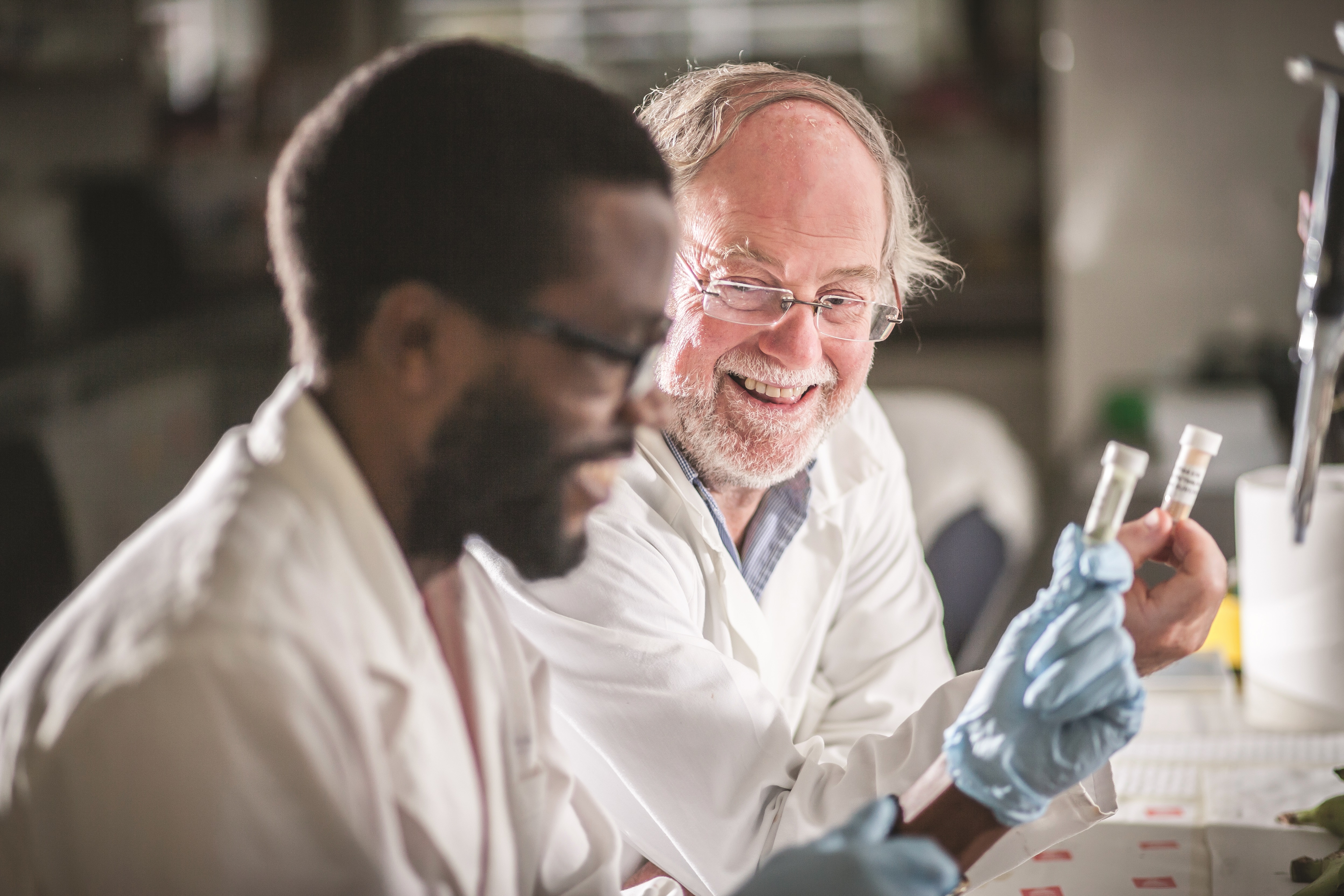
"One of the biggest impacts of this project is that it's saying to the world, and particularly the developing world, it doesn't have to be just big biotech companies that can do this," says Dale. "Tush sees that at the end of this project we can go away and he can do the next himself. I think that's amazing."
Dale was introduced to the Kawanda scientists in 2003. He was invited to a meeting in Kampala jointly organized by Debby Delmer, a plant biologist at the Rockefeller Foundation. Delmer was overseeing a project to develop disease-resistant bananas at Kawanda that the foundation was backing. Delmer was concerned that "progress was slow in Uganda and they were having trouble accessing genes," Dale says. Over a private dinner with Dale, Delmer said the Kawanda researchers were still struggling to develop the biotech skills that were part of the project's goals. She asked Dale if he would help them out, though she had no money to support him. Despite that, Dale began providing the Kawanda lab marker or test genes and other components to jump-start its expertise. Dale also began regularly exchanging emails with Tush.
The next year, Dale received a fortuitous phone call from a researcher he knew in the U.S. alerting him to the GCGH's call for grant applications to biofortify crops as a way to alleviate malnutrition in poor nations. The grant request said projects required the collaboration of a research partner in the country where the designated crop was a dietary staple. Dale contacted Tush and they sent an expression of interest to the GCGH staff. Soon after Dale was notified that he and Tush were on a short list of 450 applicants. "I thought that's a pretty long short list," Dale says. "We were elated, but surprised when we actually won the grant. Tush was overjoyed."
Dale originally requested and received about $1.1 million from the GCGH program to cover four years of research. The following year the project was provided an additional $2.8 million. "James didn't ask for enough funds when he first applied for the grant in 2004," says Fil Randazzo, the grant's project officer for GCGH in Seattle. "His technical progress, focus and leadership made it easy to continue to add significantly more funds to the investment, and additional funds and resources not long after that."
During the early years of the project, Randazzo set up a Biosafety Resource Network at the Danforth Center in St. Louis with a $5.4 million grant of which the banana project received about $1 million. Randazzo says the Danforth program was created to have "a virtual consulting team of biosafety regulatory science and regulatory affairs experts." The Danforth Center provided expertise and resources to supplement Dale and other GCGH projects to fortify nutrition of rice, cassava and sorghum.
To kick off the project, Tush invited Dale and Randazzo to visit towns and farms in especially impoverished areas to meet with health workers and the banana growers: small-holding farms typically with a hectare (2.5 acres) or less of land. Some farmers were eager to plant GM crops, assuring the researchers that they wouldn't face resistance when they were ready to introduce a GM product. A health survey they conducted found that despite government efforts to fortify diets with nutritional supplements, vitamin A deficiency among children under age five was still 15 to 30 percent. Seventy-two percent lacked necessary dietary iron.
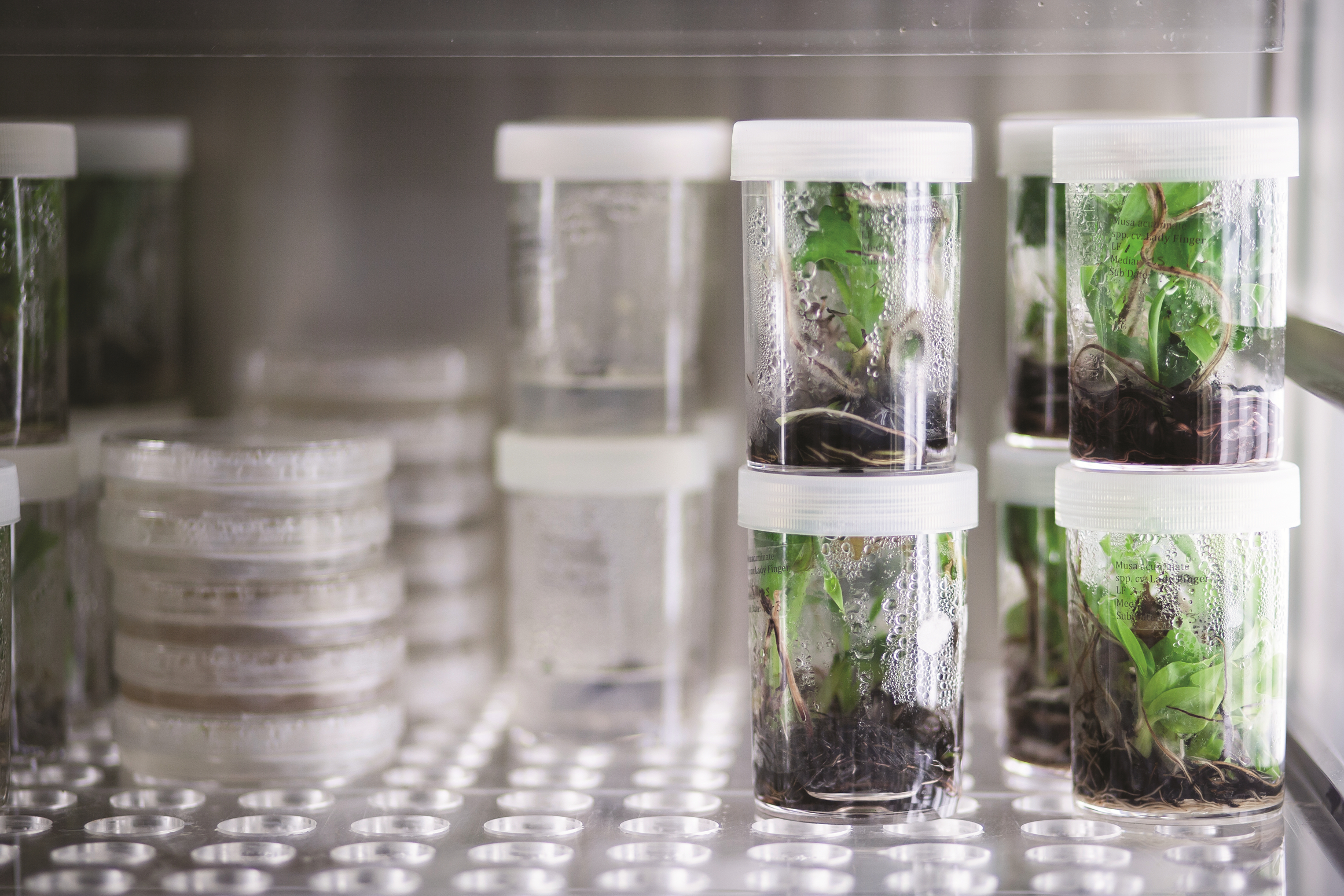
The modified banana plants are first grown under controlled laboratory conditions.
The next phase, undertaken in Dale's lab in Brisbane, was to uncover plant genes that produced high amounts of pro-vitamin A. In addition, several young members of the Kawanda facility joined Dale's lab as Ph.D. students to gain gene transfer skills they would take back to Uganda. The first group that came through was surprised by how hard we worked them, says Dale. "I told them we work 8 to 6, six days a week," Dale says. "We're doing big stuff here." (By 2015 seven Ugandans received or were about to get their Ph.D. training). The plan was to first generate the potentially higher nutrient level bananas in the Cavendish variety in the Brisbane lab, and then grow the plant to full maturity in field trials in the tropical climate near Innisfail, a town in Queensland, Australia's northeastern state. Once that was accomplished, the technology would be brought to Kawanda where the Ugandans had to show they could repeat the experiments in their lab and then in field trials at the research facility. Dale couldn't conduct the research on the African bananas due to a ban on importing plants that might introduce foreign diseases.
"So, right off we thought we'd do just what the Golden Rice project did," says Dale. Beginning in the early 1990s, scientists began looking into ways to enhance pro-vitamin A in rice to overcome vitamin deficiency in rural areas of China and Southeast Asia. By 2005, researchers who were part of what was by then a formal international consortium called "Golden Rice" had identified a gene from the maize plant that significantly enhanced the vitamin in rice grains. There was plenty of beta-carotene in the rice plant's leaves but very little accumulated in the grains. Scientists found that the grains lacked a critical enzyme that synthesized phytoene, a protein that gets converted into carotene. Maize grains had plenty of the enzyme called phytoene synthase (PSY). When the PSY gene was inserted into the rice plants, along with a bit of genetic material called a promoter that turns the gene on, the grains retained levels of pro-vitamin A well above the daily dietary requirement.
But, to Dale's disappointment, the maize gene produced banana plants with "golden" leaves or "golden" peel. "So, from there it was going to be trial and error." Dale says. However, there are types of bananas that produce very high levels of pro-vitamin A in their fruit. But they are very different to the bananas grown in Uganda. Dale was aware of these and decided to also try the phytoene synthase gene from one of these bananas, called Asupina,[1] which was from Papua New Guinea. The plant grows wild but produces small bunches of small-sized bananas with a deep orange-yellow pulp as a result of its high levels of beta-carotene. Similar bananas are also cultivated throughout Micronesia. It turns out the Asupina banana at maturity contains more than 100 micrograms (µg) of pro-vitamin A per gram of pulp. Dale had determined that 20µg/gram of pro-vitamin A in an East African Highland banana would provide half the daily dietary requirement of vitamin A.
The next step by the Brisbane lab was to find the right combination of the Asupina PSY gene (APSY) with a promoter sequence, of which there were also numerous choices, including those tried by the Golden Rice project. In the end, the lab created hundreds of different combinations, or gene constructs. In 2009, the Dale team conducted its first field trial in Queensland of 1,300 Cavendish plants, or lines, containing about 100 different gene-promoter constructs. Dale explains that they had to plant numerous lines with the same combinations because each plant, though containing the same genes, produced different levels of nutrients and appearances, for reasons that are not fully understood.
The personal visits were especially useful because Dale would spend time at the lab benches, where technicians sometimes shared technical or resource problems the Australian might not otherwise hear about.
When the plants matured a year later, only 14 normal-looking Cavendish lines contained more than a four-fold increase in pro-vitamin A, enough to hit Dale's target. Meanwhile, in 2009, the Ugandan team had its own breakthrough when, for the first time, it successfully inserted a so-called marker gene into their indigenous bananas. "This was a critically important proof of concept for the Ugandans." says Lawrence Kent, who later took over management of the project for the Gates Foundation. That same year Dale sent the Kawanda lab the transgene constructs to begin inserting into the East African Highland bananas.
Although the technique for transferring a desired gene from one plant into another was developed in the last 30 years, carrying it out in the lab is as much art as science, each step requiring dozens of attempts often over a period of months or years to get it right. First off, the researchers must insert the DNA of a new gene, such as one for beta-carotene, into the nucleus of the target plant's embryonic cells. The new gene will now be embedded in all the banana's cells and at some point in the plant's life some of these cells will produce beta-carotene. The embryonic cells are grown in a liquid media from embryos produced by growing the banana's immature male flowers. Scientists then use what Dale calls "nature's own genetic engineer," a plant bacterium called Agrobacterium. In nature, this bacterium reproduces by invading a plant cell and inserting its own DNA into the cell's nucleus. The new DNA programs the cell to produce sugars the bacterium feeds on, a process that produces galls, or benign tumor-like warts, on infected plants. Scientists mimic this process by implanting into the bacterium the DNA sequence for a desired gene such as the one for beta-carotene. When the bacterium now infects a cell it ferries with it the new gene, as well as a promoter sequence added to tell the cell when to express the pro-vitamin A protein. Banana cells with the new gene construct - DNA containing a combination of the new gene and its promoter - are then grown in tissue culture and later transferred into small pots of soil in greenhouses. At about a half meter (1.5 feet) tall, the plant can be put into a field.
Dale says one of his greatest challenges beyond the science was learning how to "steward" the international team. It was gaining a high profile amongst plant biologists, in the news media, and with researchers attempting to biofortify other crops. "The goal was clear: to produce a product that one day will be widely consumed," says Dale. "This involves skills and resources generally confined to large corporations." The Gates Foundation helped by inviting Dale to Seattle to attend workshops in leadership, communications and resource management. Dale, outgoing and generous by nature, also kept in close touch with Tush and his team, conducting monthly lab meetings via Skype, and visiting Kawanda for a week or two every two months. The personal visits were especially useful because Dale would spend time at the lab benches, where technicians sometimes shared technical or resource problems the Australian might not otherwise hear about.
"James and Tush created a special partnership at the start that was based on co-development and co-ownership of the work," says Randazzo, the GCGH project officer. "They were equal partners bringing complementary aspects to the program. We still use this as an important lesson at the foundation on how to create great research partnerships."
Still, eight years into the project the Brisbane lab had failed to find a gene construct that significantly elevated iron in banana fruit. They initially used a soybean iron storage protein. However, they subsequently utilized a rice gene that mobilizes iron within the plant.
This strategy had been developed by a fellow Australian researcher, Alex Johnson. In late 2013, the first field trials of bananas with this gene in Australia yielded one group of plants with twice the normal amount of iron. In 2014, researchers began a new field trial of Cavendish bananas that Dale believes will double that level. By 2015, the new gene constructs for iron will be handed off to Kawanda, meaning the first results of a field trial of iron-enhanced African bananas in the field might not be known until a year after that.
Meanwhile, the pro-vitamin A African bananas are in advanced field trials in Kawanda. The researchers there are developing 800 lines of two separate bananas, one called M9 that has been bred through conventional means to be disease resistant and another called Niketembe, a traditional East African Highland banana. When harvested later in 2016 the best producers, called the elite lines, will then be planted in a larger multi-site test at different locations around Uganda. Banana plants are perennials. When the mother plant is harvested it is cut down and farmers produce fruit for the next year by growing the suckers that sprout around the base of the mother. In this way, the farmers can regrow a plant with the same genetics for the following year. Perhaps by 2018, researchers will be testing an East African Highland banana with both the enhanced iron and vitamin A traits combined.
After that, researchers at Kawanda will be mostly on their own, using gene transfer skills to improve disease resistance, yield and nutrition, supported with newly minted scientists being trained in Kawanda and Brisbane. “For me, it's so satisfying," said Stephen Buah, a Ugandan doctoral candidate in Brisbane. "I can go home, conduct my own gene transfer research and train other students." Stephen has now returned to Uganda with his Ph.D. and is employed as a key scientist on the project.
THE SCIENCE:
Identifying phytoene synthase genes to increase pro-vitamin A carotenoid levels in banana
Pro-vitamin A carotenoids (pVAC) such as beta-carotene are lipophilic pigments that occur naturally in plants and are essential for growth. They are also the main dietary source of vitamin A for humans. Levels of pVAC vary widely amongst banana cultivars and are relatively low in many staple varieties in countries where vitamin A deficiency is a major health concern. Dale and colleagues have been developing methods to genetically modify bananas and other crops to enhance their nutritional content and protect them against diseases. They devised a centrifugation-assisted Agrobacterium-mediated transformation (CAAT) protocol that enabled the efficient and stable integration of transgenes into bananas.[2] Transformation efficiency was further increased upon coexpression of animal anti-apoptotic genes to inhibit Agrobacterium-induced plant cell death.[3]
Phytoene synthase (PSY) catalyzes a rate-limiting step in carotenoid biosynthesis. Specific PSY isoforms and expression levels have been linked to pVAC content in several plants. They profiled the PSY gene family in bananas and identified two para logs, the levels of which decreased in ripened fruit. Higher PSY activity was observed in Asupina cultivars carrying the A-PSY2a gene, which has an order of magnitude higher pVAC levels as compared to Cavendish cultivars.[1] This makes A-PSY2a a good candidate for modifying fruit pVAC content in other banana cultivars once a suitable promoter has been identified. Genetically modifying plants by cis- and intra-genie approaches, i.e., with sequences from related species, will expedite regulatory approval and should help overcome environmental and public concerns.
REFERENCES:
[1] [a],[b] Mlalazi B, Welsch R, Namanya P, Khanna H, Geijskes RJ, Harrison MD, Harding R, Dale JL, Bateson M. Isolation and functional characterisation of banana phytoene synthase genes as potential cisgenes. Planta 236, 1585 (2012).
[2] Khanna HK, Becker D, Kleidon J, Dale JL. Centrifugation Assisted Agrobacterium tumefaciens-mediated Transformation (CAAT) of embryogenic cell suspensions of banana (Musa spp. Cavendish AAA and Lady finger AAB). Molecular Breeding 14, 239 (2004).
[3] Khanna HK, Paul JY, Harding RM, Dickman MB, Dale JL. Inhibition of Agrobacterium-induced cell death by antiapoptotic gene expression leads to very high transformation efficiency of banana. Mol Plant Microbe Interact. 20, 1048 (2007).
